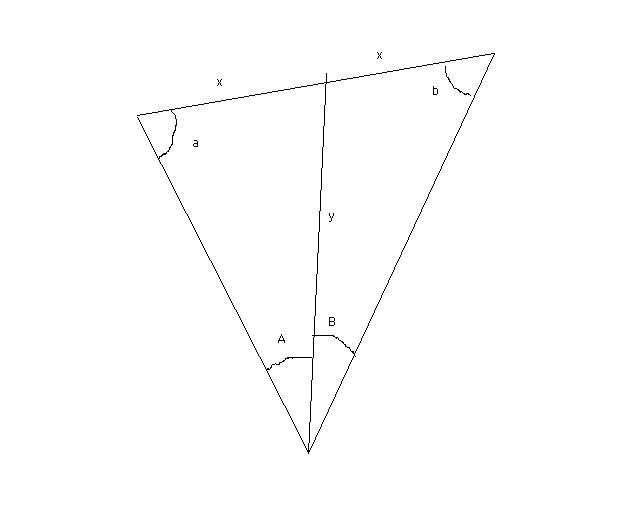|
|
#31 | ||
      Join Date: Mar 2006
Location: Krakeroy, Norway
Posts: 3,014
|
If
angle ABC = a (alpha) K = sin BAC / sin CAD and L = 180 - (BAC + CAD) then K = sin a / sin (L - a) the solution will be at sin a / sin (L - a) - K = 0 (tested and verified* with a graphical calculator) * verified as in I didn't get any wrong answers with several different, arbitrary values for BAC and CAD. Now is the problem, I am unable to isolate alpha in sin (L - a) If you can do that, you have the formula, I believe.
__________________
Je Suis Charlie Last edited by Mighty Midget; 10-08-2008 at 03:56 PM. |
||

|
|
|
|
#32 | ||
           Join Date: Feb 2007
Location: Schijndel, Netherlands
Posts: 864
|
Well ACTUALLY...
As long as the Angles @ A (or just one of) are known and E is a known value.. (Which is in the IRL issue) I just need the KNOWN value of either another angle or another side (c {AC}) Cause with the Law of sines and the 180 degrees rule I can then calculate ALL the other sides/angles.. (If I'm in the mood for it AND have my equipment @ hand)
__________________
Greetings from GTX2GvO. Member of The Victorious People's Shoutbox Liberation Army. |
||

|
|
|
|
#33 | ||
      Join Date: Mar 2006
Location: Krakeroy, Norway
Posts: 3,014
|
The segments at E are, unfortunately, unknown. The only known values are the two angles at A (angle BAC and CAD).
EDIT: Summary When the function f(a) = sin a / sin (L - a) - K = 0 that's the correct a (angle ABC)
__________________
Je Suis Charlie Last edited by Mighty Midget; 10-08-2008 at 04:27 PM. |
||

|
|
|
|
#34 | ||
      Join Date: Mar 2006
Location: Krakeroy, Norway
Posts: 3,014
|
Sorry for the double, just want to keep things tidy in a messy topic
 x / sin A = y / sin a x = y sin A / sin a ---- x / sin B = y / sin b x = y sin B / sin b ---- since x = x sin A / sin a = sin B / sin b sin A / sin B = sin a / sin b sin A / sin B = K b = 180 - (A + B) - a 180 - (A + B) = L K = sin a / sin (L - a) sin a / sin (L - a) - K = 0
__________________
Je Suis Charlie |
||

|
|
|
|
#35 | ||
        Join Date: Mar 2007
Location: Saint Catharines, Canada
Posts: 56
|
Did the ship maintain the same speed? Does the game provide velocity? How do you know the value of the angles?
|
||

|
|
|
|
#36 | ||
   Join Date: Jan 2008
Location: Christchurch, New Zealand
Posts: 1,044
|
Gaaah? Why bring up trig? *calms down a little* Sorry, I had a Maths common test this morning. I've done enough differentiation for one day.
 |
||

|
|
|
|
#37 | ||
      Join Date: Mar 2006
Location: Krakeroy, Norway
Posts: 3,014
|
Sorry for the late reply.
Doom: The angles A and B on the last diagram are calculated from 3 readings of the bearing to the ship. A and B are the difference between the 3 readings. Also, the speed is assumed to be constant, as is the heading.
__________________
Je Suis Charlie |
||

|
|
|
|
#38 | ||
            |
Ohh God, schools only 1 week, and i have to repeat all this shit!
__________________
"I want to be able to tell some poor girl i am going to feed off of, that she will see me in her dreams as a dinosaur" - DarthHelmet86 "that's what all jrpgs are about 0: intro 1: talk talk cry talk talk graphics talk talk, 2: boring jrpg generic turn based combat 3: walk map 4: goto 1 12390482309 times 5: outro" - _r.u.s.s. |
||

|
|
|
|
#39 | ||
       Join Date: Mar 2006
Location: ,
Posts: 4,613
|
I didn't read through the whole topic... You just have to state the simple relationships (equations 1 and 2) between the three angles formed by e with b, c and d (gamma, delta and epsilon in my notation). Then you use the BC=CD equation and presto, I think using the law of sines is the simplest option.

__________________
Life starts every day anew. Prospects not so good... Last edited by Japo; 27-09-2008 at 10:55 PM. |
||

|
|
|
|
#40 | ||
      Join Date: Mar 2006
Location: Krakeroy, Norway
Posts: 3,014
|
Thanks a bunch, Japofran! I will look into this, but it looks promising.
Ok, here's another one: From a defined point on Earth, you know your distance from that point as well as your bearing as seen from that point (that is, if you are due east of that point, you are at bearing 90 degrees, if you are due north, your bearing is 360, and so on). If your coordinates are 136 70, you are at bearing 136 (South East) at a distance of 70 (be it mm, metres, miles or whatever) from the point. Your coordinates are [b d] (b being bearing, d being distance) You also know your own heading h, that is which direction you're facing i.e. 25 degrees (North North East). You are then to move from coordinates [b d] to a new location given by the coordinates [B D] What is your new heading H, how many degrees will you have to turn and in which direction (smallest angle), and what is the distance from [b d] to [B D]?
__________________
Je Suis Charlie |
||

|
|